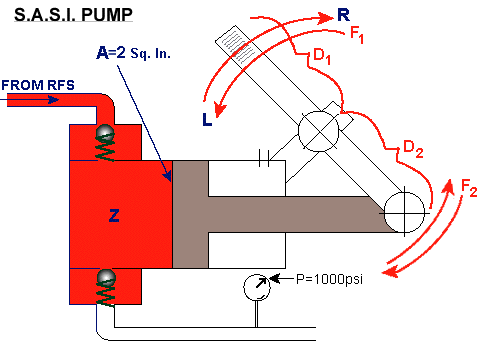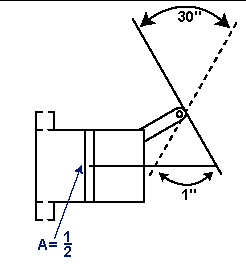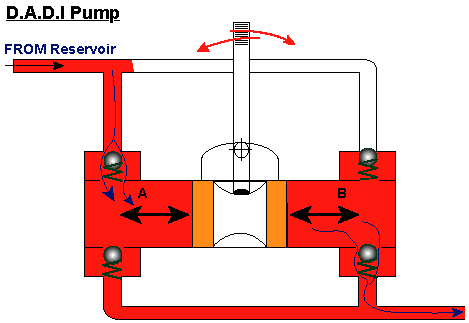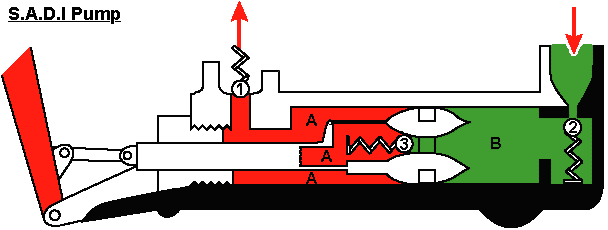 |
|||||
| Home | Research | For Teachers | HISTORY Level 1 Level 2 Level 3 |
PRINCIPLES Level 1 Level 2 Level 3 |
CAREER Level 1 Level 2 Level 3 |
| Gallery | Hot Links | What's New! | |||
| Web Administration and Tools | |||||
 |
|||||
| Home | Research | For Teachers | HISTORY Level 1 Level 2 Level 3 |
PRINCIPLES Level 1 Level 2 Level 3 |
CAREER Level 1 Level 2 Level 3 |
| Gallery | Hot Links | What's New! | |||
| Web Administration and Tools | |||||
![]()
The hand pump converts the power of a human being to hydraulic horsepower. For this reason, such pumps are used in older model aircraft.
There are several types of handpumps.
The pump works on the principle of mechanical advantage.
When pilot moves the handle away to L (see diagram below), a low pressure is caused
to form in the chamber of the pump, Z. Since the reservoir liquid pressure is greater than
the pressure in Z, liquid is forced around the check valve from the reservoir line. When
the pump handle is moved to R, a positive pressure will form in Z, causing the check valve
to the reservoir side to close. Since the hydraulic system liquid is incompressible, it is
forced out through the bottom check valve to the system line.
Suppose the force delivered by the pilot was F1 = 100 lb, at a distance D1
= 20 inches from the pump handle pivot, and suppose that D2 = 1 inch from the
pivot to the pump piston. Then by moment equilibrium (F1D1=F2D2),
the force acting on the piston would be F2 = 2000 lb. If the piston area on
which the oil acts is A = 2 square inches, then the pressure developed is ![]()

The volumetric output ![]() . In this
case,
. In this
case, ![]() . But a
man’s average output is about 50 lb for F1. Therefore, the piston area
must be made half its present size (if the pressure is to remain constant). Thus,
volumetric output will then decrease to 1 cu. in., since
. But a
man’s average output is about 50 lb for F1. Therefore, the piston area
must be made half its present size (if the pressure is to remain constant). Thus,
volumetric output will then decrease to 1 cu. in., since ![]() .
.
Problem: (SASI Pump)
 Given
a SASI pump connected to a hydraulic system under 3000 psi pressure and the mechanical
advantage of the pump (the ratio of D1 to D2 ) to be 30 to 1, find:
Given
a SASI pump connected to a hydraulic system under 3000 psi pressure and the mechanical
advantage of the pump (the ratio of D1 to D2 ) to be 30 to 1, find:
1) the number of cycles needed to pump 300 cubic inches of fluid into the system;
and,
2) the force to be applied at the pump handle. Assume that the piston surface area
is 0.5 square inches.
Since the system pressure = 3000 psi and this acts on a surface area of 1/2 square inch, the force generated by the hydraulic fluid is 1500 lbs.
Using the mechanical advantage of 30 to 1, we find that the force at the pump handle will be
![]() or
or ![]() .
.
Since the piston stroke is D2, the volume moved per cycle is D2 times the piston surface area
![]()
or
![]()
Thus, per cycle, 0.5 cubic inches of fluid is pumped into the system.
The number of cycles needed to pump 300 cubic inches of fluid may be found from
![]()
then
![]()
The DADI pump works in the same way that the SASI pump works, except that while chamber A is filling up from the reservoir, chamber B is pumping oil to the system.

As the pump handle pulls the piston to the left, the oil trapped in A is pushed out through check valve 1 to the system. At the same time, a low pressure is created in B and ball 2 opens, letting in oil. As the pump handle pushes the piston to the right, a positive pressure is created in B which closes check valve 2. But, since oil in B is trapped, it escapes to side A when the pressure is great enough to open check valve 3. Now that the oil is in side A, the pressure on that side is still great enough to open check valve 1.

Send all comments to ![]() aeromaster@eng.fiu.edu
aeromaster@eng.fiu.edu
© 1995-98 ALLSTAR Network. All rights reserved worldwide.
Updated: February 17, 1999